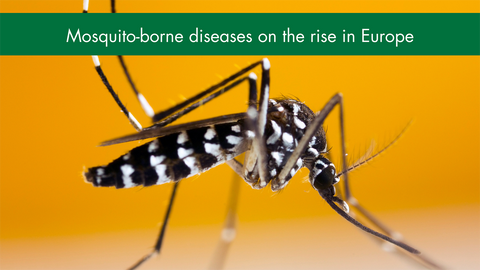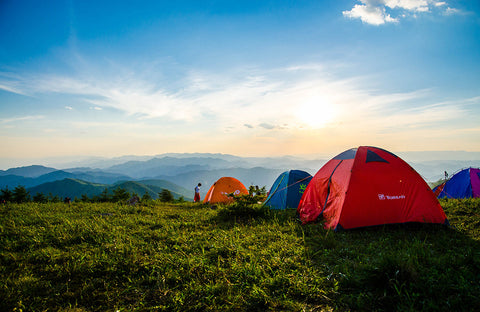Warning! Disease-carrying mosquitoes are now in Europe!
The threat from mosquito-borne diseases such as dengue fever, Chikungunya, yellow fever, West Nile virus and Zika has never been higher, since records begun. The two potentially dangerous mosquito species, Aedes albopictus and Aedes Aegypti, are firmly established in Europe and the UK. “So it’s really important for people to protect themselves from mosquitoes at home as well as when travelling and holidaying abroad, including Europe” says bite prevention expert Howard Carter.
The World Health Organization (WHO) has issued a warning about an alarming rise in dengue cases and other mosquito-borne arboviruses such as chikungunya. This comes mainly as a result of climate change, which is creating ideal conditions for these diseases to spread. Concerns have been raised that global outbreaks could be imminent.*
Climate change
Unusually high temperatures and recent changes in rainfall patterns have created favourable conditions for mosquito breeding, survival, and the spread of these diseases. Extended mosquito seasons and the expansion of mosquito habitats into new areas increase the risk of transmission. Additionally, extreme weather events, such as heavy rainfall and flooding, can contribute to the accumulation of stagnant water, which serve as breeding grounds for mosquitoes.
“Latest information from the ECDC (European Centre for Disease Prevention and Control) says that there were 1,133 cases of West Nile virus in Europe, with 92 deaths,” continues Howard. “1,112 of these were locally caught, across 11 European countries – the highest since 2018, the peak epidemic year.
“The ECDC also reports that there were nearly as many locally caught cases of dengue fever In Europe as there had been in the previous 11 years, mainly in France.”
“The evolution of dengue fever has taken a new turn,” continues Howard. “An explosion in mosquito numbers and expansion into more areas and regions mainly due to climate change, personal travel and globalisation means around 50% of the world’s population is now at risk, this includes UK citizens when they travel.”
“In fact UK travellers return home with more mosquito-borne diseases than all other European countries combined.”
“I witnessed first hand the presence of the Asian tiger mosquito in the south-east of England in 2010, and it is now firmly established in Kent and the surrounding countryside. I cannot stress enough that people living in these areas should use insect repellent because every person bitten means another 200 mosquito eggs born!”
“Dengue fever is now the most prevalent tropical disease amongst travellers returning to the UK. For example in Sri Lanka, where June and July are the worst months, 0.03% of the population is infected and 25% of the country’s entire health budget is spent fighting it. Since the beginning of 2023, the National Dengue Control Unit (NDCU) in Sri Lanka has reported over 36,000 dengue cases – around three times higher than during the same period in the past two years.” Peru recently declared a state of emergency due to the rise in this disease.
“Dengue fever symptoms include high temperature, headache, pain behind the eyes, and bone, muscle and joint pain, but can be more severe and even sometimes fatal. It is carried by mosquitoes that bite during the day from dawn to dusk: Aedes aegypti and Aedes albopictus species. Aedes albopictus, also known as the Asian tiger mosquito, represents the highest risk to people being bitten, now that it has established itself in the south east of England.”
“Chikungunya is another arboviral disease transmitted by Aedes mosquitoes that is on the rise; so much so that it is currently considered a global health emergency. It causes high fever and joint and muscle pain. Although it is rarely fatal, it can be debilitating and result in chronic pain and arthritis-like symptoms. It can reoccur throughout a person’s lifetime and victims are often identified as stooping.”
“As these female mosquitoes are active during the day – unlike malaria-carrying mosquitoes which bite during the night – daytime protection is becoming more important than night time defence”. This is often how people get caught out, assuming most mosquitoes bite at night time and not taking precautions during the day in areas at risk.
Both diseases can cause similar symptoms, including high fever, severe joint and muscle pain, headache, and rash. In some cases, they can lead to more severe complications.
Dengue:
- dengue fever can cause a range of symptoms, from mild to severe. Mild cases may present with high fever, headache, joint and muscle pain, rash, and mild bleeding. Severe cases, known as dengue haemorrhagic fever or dengue shock syndrome, can be life-threatening and may involve severe bleeding, organ damage, and shock.
- There is no specific treatment for dengue fever. Supportive care, such as rest, fluid replacement, and pain relief, is usually provided to manage symptoms. Severe cases require immediate medical attention.
Chikungunya:
- Chikungunya typically presents with symptoms such as high fever, severe joint pain, headache, muscle pain, rash, and fatigue. Joint pain is often a prominent feature and can persist for months or even years in some cases.
- Like dengue, there is no specific antiviral treatment for chikungunya. Treatment focuses on relieving symptoms, such as pain and fever, through rest, hydration, and over-the-counter pain medications.
Prevention for both diseases involve reducing mosquito breeding sites, using mosquito repellents, wearing protective clothing, and implementing mosquito control measures. Public health efforts also focus on surveillance, early detection, and community education to minimize the impact of these diseases.
Approximately 50% of the world's population is now at risk of dengue and chikungunya. These diseases are endemic in many tropical and subtropical regions where the Aedes mosquitoes thrive. Rapid urbanization, increased international travel, and climate change have contributed to the expansion of the mosquitoes' habitat and the diseases' spread. Efforts to control mosquito populations and raise awareness about preventive measures are crucial in reducing the risk of dengue and chikungunya worldwide.
Prevention and Protection
As these female mosquitos are active during the day – unlike malaria-carrying mosquitoes which bite during the night – daytime protection is becoming more important than night time defence.
Following our C.L.O.A.K method for effective bite prevention, at home as well as abroad.
And remember: a lot of mosquitoes zero in on the ears, wrists and ankles because this is where the skin in thinner and blood vessels are nearer the surface; which is one of the reasons women generally getting bitten more than men. It is a good idea to only wash with products that contain java citronella. Explore our body care range here.
C.L.O.A.K
C – Cover up skin as much as possible with suitable clothing, especially arms and legs. You can also soak clothes with 10-20 drops of Java citronella (not the cheaper & less effective C. nardus) diluted in water & leave for 15 minutes or more.
L – Light coloured Loose clothing is advisable to wear as mosquitoes are attracted to dark colours.
O – Odours, both bodily & otherwise e.g. perfumes & nearly all scented toiletries attract insects to you. Therefore, it is key to wash thoroughly morning and evening with our citrus-aromatic HAIR & BODYWASH. Use a loofah every other day to remove dirt from skin pores if you are very attractive to insects e.g. get bitten in the UK: unlike synthetic mittens and other man-made exfoliators, only a natural loofah has microscopic hairs to remove the detritus.
A – Apply incognito® 100% effective insect repellent spray, roll-on, lotion or suncream repellent on exposed skin. Reapply every 4-5 hours or whenever necessary.
K – Keep mosquitoes out of your dwelling by using an incognito® ROOM REFRESHER OR INCENSE STICKS. Keep away from stagnant water.
The department of disease control at the London School of Hygiene & Tropical Medicine and the NHS recommends ONLY 2 actives to be used in high-risk areas where mosquito-borne illnesses could be present: DEET & PMD The latter is used in all our biocidal repellents & the former should not be used for children as it is a neurotoxin!
Our formulation is made through a unique secret process that increases the duration of efficacy by 22% and gives 100% complete protection time (CPT) for five hours. This special concoction is in all our repellents, it is derived from the purest form of natural PMD and is 100% effective against all the main disease-carrying mosquitoes in extensive testing.
* Sky news




Comments (0)
There are no comments for this article. Be the first one to leave a message!